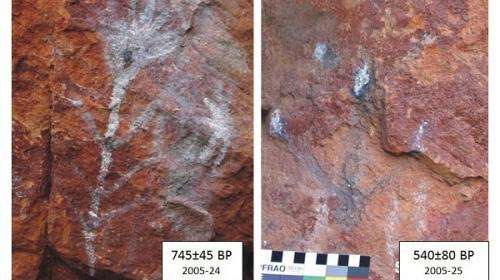W/Prof McDonald says they successfully dated paintings from the last 2-3,000 years before the present and that this painting activity matches an increased intensity of site occupation generally. Credit: Jo McDonald
An interdisciplinary team has used a new technique known as plasma oxidation to produce radio carbon dates for paint fragments as small as 10 micrograms in width.
Archaeologist and UWA Winthrop Professor Jo McDonald, says her team spent three years documenting rock art sites along the Canning Stock Route, in the eastern Pilbara, at the request of traditional owners.
"A lot of them had had not been visited for a very long time," she says.
"The community hasn't lived on country since the 1960s – but we had a couple of traditional owners with us who had walked through those areas in the 70s."
W/Prof McDonald says the team documented several art styles at the Carnarvon, Jilakuru and Calvert Ranges with the community's permission, taking careful pigment samples.
In each case they had to tread a fine line between taking a sample big enough to be dated, and destroying the painting.
"We had about a 50 per cent success rate in collecting samples yielding enough carbon," W/Prof McDonald says.
"We used sterile scalpels and surgical gloves and sterile silver foil as part of the process.
"We tried to target motifs that had visible amounts of pigment on them, but also ones that were flaking off and would naturally lose these pigment pieces.
"We didn't want to create any additional damage if we could avoid it."
US-based chemist Dr Karen Steelman then treated the samples at the plasma oxidation laboratory she has built at the University of Central Arkansas.
The process produces a graphite target, which Dr Steelman then sends to the Lawrence Livermore laboratories at Berkeley, California, for Accelerator Mass Spectrometry (AMS) analysis.
W/Prof McDonald says they successfully dated paintings from the last 2-3,000 years before the present and that this painting activity matches an increased intensity of site occupation generally.
These results provide the first dates for painting activity in the Australian Western Desert, and this project has yielded more direct art dates than any other in the world.
"We have discovered that this technique is a useful way of dating black paintings with charcoal in them," W/Prof McDonald says.
Some ochre-based paintings appear to be much older, but could not be radio carbon dated as the paints contained no detectable or organic binders.
W/Prof McDonald says some of this older art is covered by oxalate crusts, which may make it possible to employ an isotopic method such as Uranium Thorium dating.
More information: Jo McDonald, Karen L. Steelman, Peter Veth, Jeremy Mackey, Josh Loewen, Casey R. Thurber, T.P. Guilderson, "Results from the first intensive dating program for pigment art in the Australian arid zone: insights into recent social complexity," Journal of Archaeological Science, Volume 46, June 2014, Pages 195-204, ISSN 0305-4403, dx.doi.org/10.1016/j.jas.2014.03.012.
Journal information: Journal of Archaeological Science
Provided by Science Network WA





















